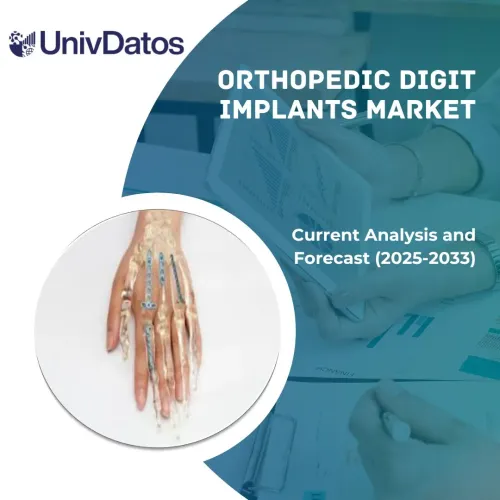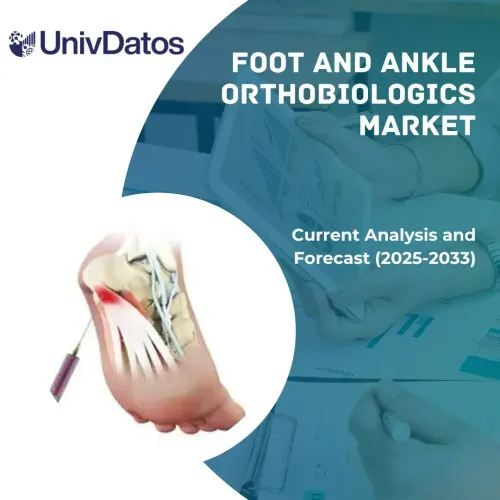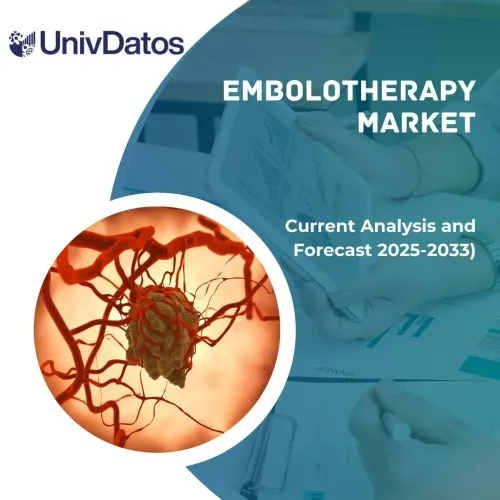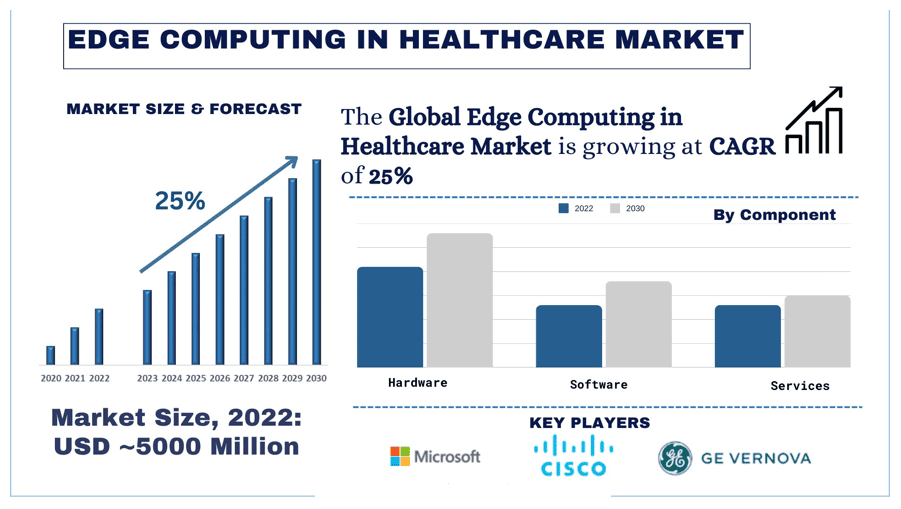
헬스케어 분야의 에지 컴퓨팅 시장 규모 및 예측
헬스케어 분야의 에지 컴퓨팅 시장은 50억 달러로 평가되었으며, 의료 기기에서 IoT 채택이 증가함에 따라 예측 기간(2024-2032) 동안 약 25%의 강력한 CAGR로 성장할 것으로 예상됩니다.
헬스케어 분야의 에지 컴퓨팅 시장 분석
에지 컴퓨팅은 의료 분야에서 중요한 기술로 부상하여 진료 시점에서 실시간 데이터 처리 및 분석을 제공합니다. 헬스케어 조직이 디지털 전환과 데이터 기반 의사 결정을 계속 우선시함에 따라 에지 컴퓨팅은 헬스케어 제공 및 환자 결과의 미래를 형성하는 데 중요한 역할을 할 것으로 예상됩니다. 디지털 전환 시대에 헬스케어는 환자 치료를 개선하고 운영을 최적화하며 전반적인 효율성을 향상시키기 위해 혁신적인 기술을 채택하고 있습니다. 헬스케어 산업에서 파장을 일으키고 있는 기술 중 하나가 에지 컴퓨팅입니다. 에지 컴퓨팅은 데이터 처리를 소스에 더 가깝게 가져와 실시간 통찰력을 제공하고 원활한 연결을 촉진함으로써 헬스케어를 혁신할 수 있는 엄청난 잠재력을 가지고 있습니다. 이 기사에서는 헬스케어에서 에지 컴퓨팅의 역할, 이점, 과제 및 실제 적용 사례를 살펴봅니다.
또한 Intel에서 실시한 연구에 따르면 에지 컴퓨팅은 의료 영상 분석의 대기 시간을 몇 분에서 밀리초로 줄여 더 빠른 진단 및 치료 계획을 가능하게 했습니다.
캘리포니아 대학교 샌프란시스코(UCSF)는 웨어러블 센서에서 데이터를 분석하기 위해 에지 컴퓨팅 솔루션을 구현하여 중환자실에서 환자 악화를 감지하는 데 필요한 시간을 90% 단축했습니다.
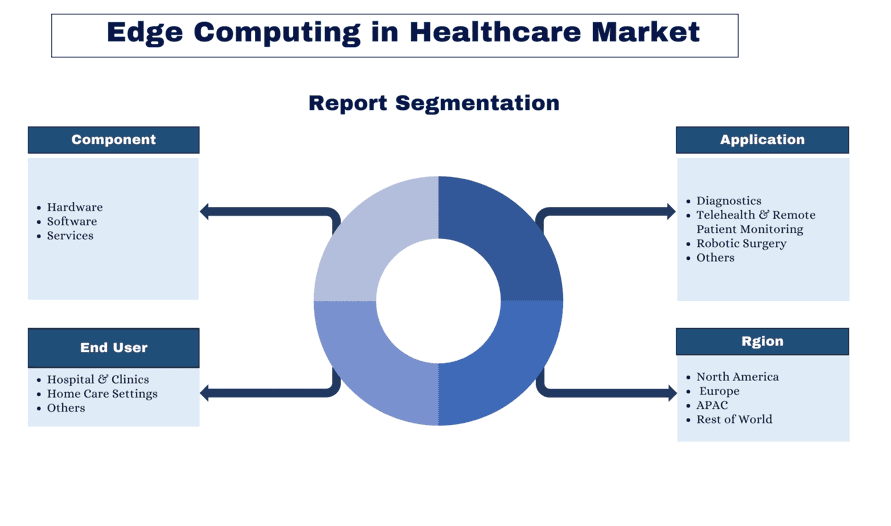
북미는 예측 기간 동안 상당한 CAGR로 성장할 것으로 예상됩니다.
북미 내에서 미국은 시장의 주요 점유율을 차지합니다. 국가의 시장 성장을 촉진하는 주요 요인은 디지털화 증가, R&D에 대한 관심 증가, 잘 구축된 의료 인프라 및 여러 시장 참여자의 존재입니다.
HHS 시민 권리국(OCR) 데이터 침해 포털의 데이터에 따르면 의료 부문은 2023년 상반기에만 약 295건의 침해를 겪었습니다. 올해 상반기에 3,900만 명 이상의 개인이 의료 데이터 침해에 연루되었습니다. 예를 들어, 2023년 3월에 PharMerica는 580만 명 이상의 개인에게 영향을 미친 OCR에 의해 침해가 공개되었습니다. PharMerica는 켄터키주 루이빌에 위치하고 있으며 모회사인 BrightSpring Health Services에서 운영합니다.
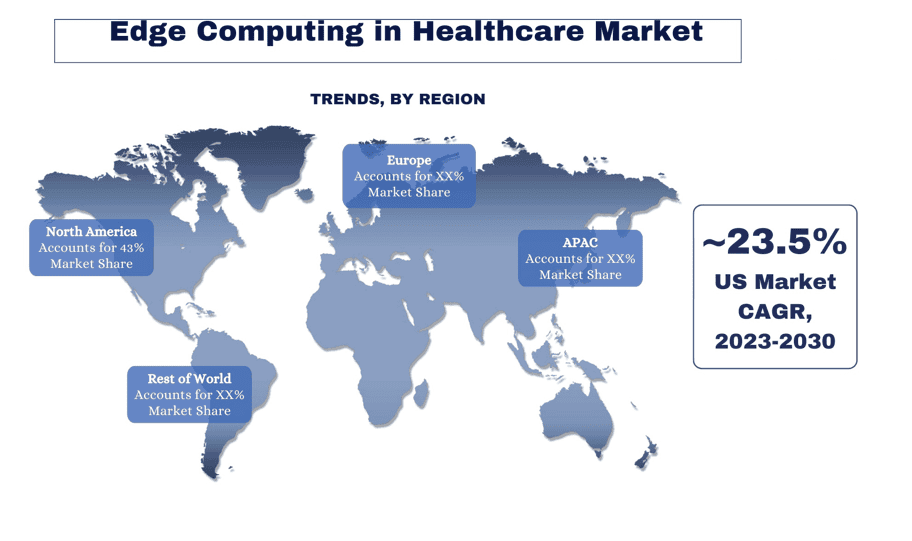
헬스케어 산업 개요의 에지 컴퓨팅
헬스케어 시장의 에지 컴퓨팅은 여러 글로벌 및 국제 시장 참여자의 존재로 인해 경쟁이 치열하고 파편화되어 있습니다. 주요 업체는 파트너십, 계약, 협업, 신제품 출시, 지리적 확장, 인수 합병과 같은 다양한 성장 전략을 채택하여 시장 입지를 강화하고 있습니다. 시장에서 활동하는 주요 업체로는 CISCO System, Inc., Dell Technologies, Inc., Amazon Web Services, Google, Inc., Microsoft Coorporation, Intel Corporation, General Electric Digital, Hewlett Packard Enterprice Company, VMware, Inc. 및 HUAWEI Technologies Co. Ltd.가 있습니다.
헬스케어 시장 보고서 범위의 에지 컴퓨팅
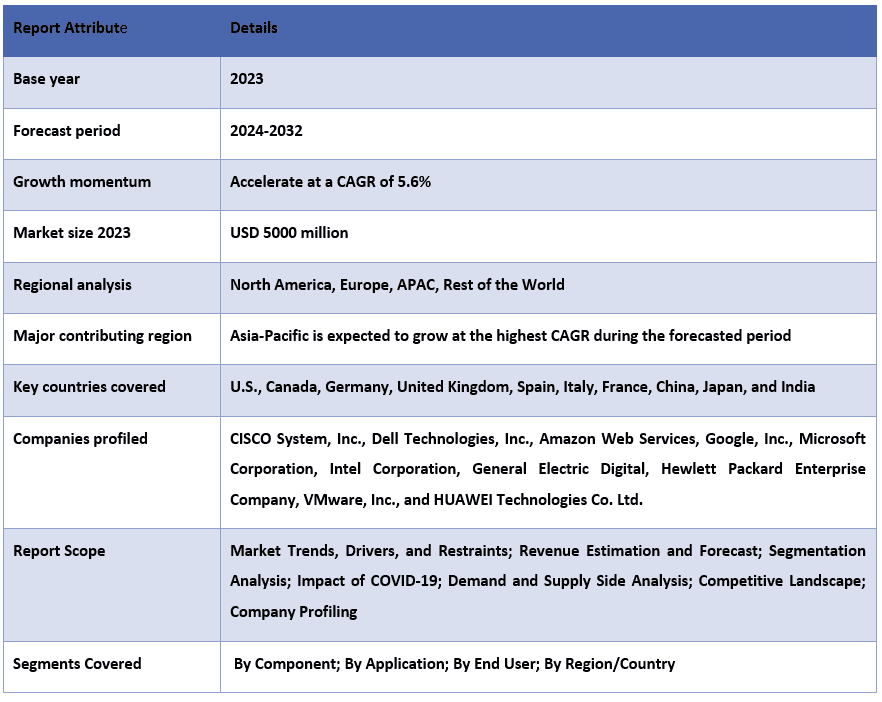
헬스케어 시장 뉴스에서 에지 컴퓨팅
- 2023년 2월, NTT DATA와의 파트너십을 통해 자동차, 물류, 헬스케어, 소매 및 공공 부문 전반에서 Cisco System에 의해 사설 5G 채택 및 에지 컴퓨팅 솔루션이 강화되었습니다.
- 2022년 2월, Kyndryl은 Amazon Web Services와 협력하여 공동 솔루션을 제공하기 위한 클라우드 센터 오브 엑설런스를 시작했습니다.
이 보고서를 구매해야 하는 이유:
- 이 연구에는 인증된 주요 산업 전문가가 검증한 시장 규모 조정 및 예측 분석이 포함되어 있습니다.
- 이 보고서는 전반적인 산업 성과에 대한 빠른 검토를 한눈에 제공합니다.
- 이 보고서는 주요 비즈니스 재무, 제품 포트폴리오, 확장 전략 및 최근 개발에 대한 주요 초점을 통해 저명한 산업 동료에 대한 심층 분석을 다룹니다.
- 산업에서 널리 퍼져 있는 동인, 제약, 주요 동향 및 기회에 대한 자세한 조사.
- 이 연구는 다양한 세그먼트에 걸쳐 시장을 포괄적으로 다룹니다.
- 산업에 대한 심층적인 지역 수준 분석.
사용자 지정 옵션:
헬스케어 시장의 글로벌 에지 컴퓨팅은 요구 사항 또는 기타 시장 부문에 따라 추가로 사용자 정의할 수 있습니다. 이 외에도 UMI는 귀하가 자체 비즈니스 요구 사항을 가질 수 있음을 이해하므로 귀하의 요구 사항에 완벽하게 맞는 보고서를 얻기 위해 언제든지 저희에게 연락하십시오.
목차
헬스케어 시장 분석의 엣지 컴퓨팅에 대한 연구 방법론 (2024-2032)
글로벌 헬스케어 시장의 엣지 컴퓨팅에 대한 과거 시장 분석, 현재 시장 추정, 미래 시장 예측은 전 세계 주요 지역에서 헬스케어의 엣지 컴퓨팅 도입을 분석하고 창출하기 위해 수행된 세 가지 주요 단계였습니다. 과거 시장 수치를 수집하고 현재 시장 규모를 추정하기 위해 광범위한 2차 조사가 수행되었습니다. 둘째, 이러한 통찰력을 검증하기 위해 수많은 결과 및 가정이 고려되었습니다. 또한, 글로벌 헬스케어 시장의 엣지 컴퓨팅의 가치 사슬 전반에 걸쳐 업계 전문가들과 광범위한 1차 인터뷰도 진행했습니다. 1차 인터뷰를 통해 시장 수치를 가정하고 검증한 후, 전체 시장 규모를 예측하기 위해 하향식/상향식 접근 방식을 사용했습니다. 이후, 산업 관련 세그먼트 및 하위 세그먼트의 시장 규모를 추정하고 분석하기 위해 시장 세분화 및 데이터 삼각 측량 방법을 채택했습니다. 자세한 방법론은 아래에 설명되어 있습니다.
과거 시장 규모 분석
1단계: 2차 출처에 대한 심층 연구:
연간 보고서 및 재무 제표, 실적 발표, 보도 자료 등과 같은 회사 내부 소스와 저널, 뉴스 및 기사, 정부 간행물, 경쟁사 간행물, 부문 보고서, 타사 데이터베이스 및 기타 신뢰할 수 있는 간행물을 포함한 외부 소스를 통해 헬스케어 시장의 엣지 컴퓨팅의 과거 시장 규모를 확보하기 위해 자세한 2차 연구가 수행되었습니다.
2단계: 시장 세분화:
헬스케어 시장의 엣지 컴퓨팅의 과거 시장 규모를 확보한 후, 주요 지역의 다양한 세그먼트 및 하위 세그먼트에 대한 과거 시장 통찰력과 점유율을 수집하기 위해 자세한 2차 분석을 수행했습니다. 주요 세그먼트는 보고서에 유형, 기술, 구성 요소 및 최종 사용자로 포함되어 있습니다. 또한 해당 지역의 테스트 모델의 전반적인 도입을 평가하기 위해 국가 수준 분석을 수행했습니다.
3단계: 요인 분석:
다양한 세그먼트 및 하위 세그먼트의 과거 시장 규모를 확보한 후, 헬스케어 시장의 엣지 컴퓨팅의 현재 시장 규모를 추정하기 위해 자세한 요인 분석을 수행했습니다. 또한, 헬스케어 시장의 엣지 컴퓨팅의 유형, 기술, 구성 요소 및 최종 사용자와 같은 종속 변수 및 독립 변수를 사용하여 요인 분석을 수행했습니다. 전 세계 헬스케어 시장의 엣지 컴퓨팅 부문에서 최고의 파트너십, 합병 및 인수, 사업 확장 및 제품 출시를 고려하여 수요 및 공급 측면 시나리오에 대한 철저한 분석이 수행되었습니다.
현재 시장 규모 추정 및 예측
현재 시장 규모 산정: 위의 3단계에서 얻은 실행 가능한 통찰력을 바탕으로 현재 시장 규모, 글로벌 헬스케어 시장의 엣지 컴퓨팅의 주요 업체 및 세그먼트의 시장 점유율을 파악했습니다. 필요한 모든 백분율 점유율 분할 및 시장 세분화는 위에 언급된 2차 접근 방식을 사용하여 결정되었으며 1차 인터뷰를 통해 검증되었습니다.
추정 및 예측: 시장 추정 및 예측을 위해 이해 관계자에게 제공되는 동인 및 추세, 제약 및 기회를 포함한 다양한 요인에 가중치를 할당했습니다. 이러한 요인을 분석한 후, 관련 예측 기술, 즉 하향식/상향식 접근 방식을 적용하여 전 세계 주요 시장에서 다양한 세그먼트 및 하위 세그먼트에 대한 2030년 시장 예측을 도출했습니다. 시장 규모를 추정하기 위해 채택된 연구 방법론은 다음을 포함합니다.
- 수익(USD) 측면에서 업계의 시장 규모와 국내 주요 시장에서 헬스케어 시장의 엣지 컴퓨팅의 도입률
- 시장 세그먼트 및 하위 세그먼트의 모든 백분율 점유율, 분할 및 세분화
- 제공되는 제품 측면에서 글로벌 헬스케어 시장의 엣지 컴퓨팅의 주요 업체. 또한 빠르게 성장하는 시장에서 경쟁하기 위해 이러한 업체가 채택한 성장 전략
시장 규모 및 점유율 검증
1차 연구: 주요 지역에서 최고 경영진(CXO/VP, 영업 책임자, 마케팅 책임자, 운영 책임자, 지역 책임자, 국가 책임자 등)을 포함한 핵심 오피니언 리더(KOL)와 심층 인터뷰를 진행했습니다. 그런 다음 1차 연구 결과를 요약하고 통계 분석을 수행하여 명시된 가설을 입증했습니다. 1차 연구의 입력은 2차 결과와 통합되어 정보를 실행 가능한 통찰력으로 전환했습니다.
다양한 지역의 1차 참가자 분할
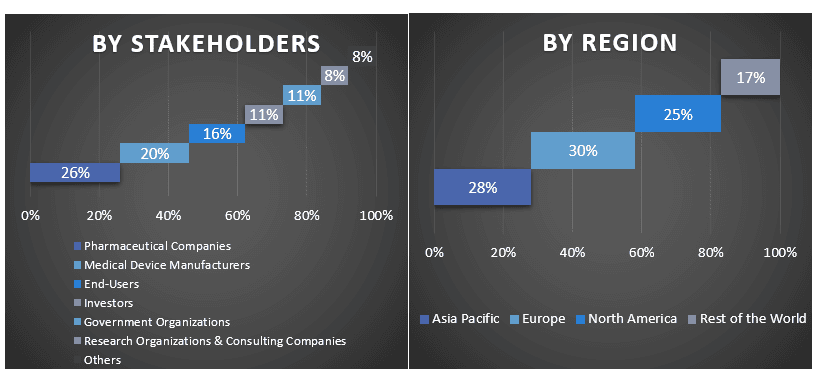
시장 엔지니어링
전반적인 시장 추정을 완료하고 글로벌 헬스케어 시장의 엣지 컴퓨팅의 각 세그먼트 및 하위 세그먼트에 대한 정확한 통계 수치를 도출하기 위해 데이터 삼각 측량 기술을 사용했습니다. 데이터는 글로벌 헬스케어 시장의 엣지 컴퓨팅에서 유형, 기술, 구성 요소 및 최종 사용자의 영역에서 다양한 매개변수 및 추세를 연구한 후 여러 세그먼트 및 하위 세그먼트로 분할되었습니다.
글로벌 헬스케어 시장 연구의 엣지 컴퓨팅의 주요 목표
글로벌 헬스케어 시장의 엣지 컴퓨팅의 현재 및 미래 시장 동향은 연구에서 정확히 지적되었습니다. 투자자는 연구에서 수행된 정성적 및 정량적 분석을 기반으로 투자를 재량에 따라 사용할 수 있는 전략적 통찰력을 얻을 수 있습니다. 현재 및 미래 시장 동향은 지역 수준에서 시장의 전반적인 매력을 결정하여 산업 참가자가 최초 진입자 이점으로부터 이익을 얻기 위해 미개척 시장을 활용할 수 있는 플랫폼을 제공합니다. 연구의 다른 정량적 목표는 다음과 같습니다.
- 가치(USD) 측면에서 헬스케어 시장의 엣지 컴퓨팅의 현재 및 예측 시장 규모를 분석합니다. 또한 다양한 세그먼트 및 하위 세그먼트의 현재 및 예측 시장 규모를 분석합니다.
- 연구의 세그먼트에는 유형, 기술, 구성 요소 및 최종 사용자의 영역이 포함됩니다.
- 헬스케어 산업의 엣지 컴퓨팅에 대한 규제 프레임워크 정의 및 분석
- 다양한 중개인의 존재와 관련된 가치 사슬을 분석하고 업계의 고객 및 경쟁사 행동을 분석합니다.
- 주요 지역에 대한 헬스케어 시장의 엣지 컴퓨팅의 현재 및 예측 시장 규모를 분석합니다.
- 보고서에서 연구된 지역의 주요 국가에는 아시아 태평양, 유럽, 북미 및 기타 세계가 포함됩니다.
- 헬스케어 시장의 엣지 컴퓨팅의 회사 프로필과 빠르게 성장하는 시장에서 생존하기 위해 시장 참여자가 채택한 성장 전략
- 업계에 대한 심층적인 지역 수준 분석
자주 묻는 질문 자주 묻는 질문
Q1: 헬스케어 분야의 엣지 컴퓨팅 시장의 현재 시장 규모와 성장 잠재력은 무엇입니까?
Q2: 헬스케어 시장에서 에지 컴퓨팅 성장의 주요 동인은 무엇입니까?
Q3: 구성 요소별 의료 분야 Edge Computing 시장에서 가장 큰 점유율을 차지하는 부문은 어디입니까?
Q4: 헬스케어 시장의 엣지 컴퓨팅에서 떠오르는 기술과 트렌드는 무엇입니까?
Q5: 의료 분야 에지 컴퓨팅 시장을 지배할 지역은 어디입니까?
관련 보고서
이 상품을 구매한 고객님들도 함께 구매하신 상품





